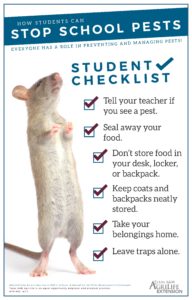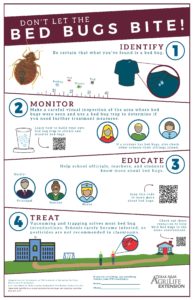 Integrated pest management (IPM) is a process that requires cooperation among all school staff members, faculty and students and pest management professionals within a school district. IPM is a strategy of managing pests using multiple control tactics that provide the best control with the least cost and environmental impact. IPM is based on thorough knowledge of the pests and the technologies used to control them and can be performed by anyone with proper training. A good IPM program attempts to make schools less hospitable to pests by modifying the environment and by using the lowest impact pesticides necessary. Managing risks from pests and risks from the pesticides used to control them are top priorities under an IPM program.
Integrated pest management (IPM) is a process that requires cooperation among all school staff members, faculty and students and pest management professionals within a school district. IPM is a strategy of managing pests using multiple control tactics that provide the best control with the least cost and environmental impact. IPM is based on thorough knowledge of the pests and the technologies used to control them and can be performed by anyone with proper training. A good IPM program attempts to make schools less hospitable to pests by modifying the environment and by using the lowest impact pesticides necessary. Managing risks from pests and risks from the pesticides used to control them are top priorities under an IPM program.
Having a sustainable IPM program takes time, effort, and people. Simply adopting IPM tenets and practices is part of the solution, but having a well thought out program takes some effort. Each school or district should have a designated IPM coordinator (“The Bug Stops Here” person). All reports and complaints should be directed to the coordinator’s office. The IPM coordinator should be viewed as an important part of the overall environmental quality team for the school or district. When it comes to IPM, cooperation is the key to successful operation. The IPM Coordinator for the school system needs to be an individual who can work with upper administration, principals, teachers, custodians, food service, and maintenance. The IPM Coordinator needs to have the ability to request work orders and have some input regarding how repairs are made. This individual also needs to be able to request that custodial crews undertake special deep cleaning projects when necessary. The coordinator also needs to be able to work with food service staff on continual maintenance and implementation of IPM practices in order to make these areas less pest friendly. The coordinator must also have the ability to work with campus teachers and principals to change practices that cause conditions conducive for pests.
IPM is information intensive; the coordinator should have time to attend conferences and other educational programs so that he/she can keep up with all the trends on pests and pest treatments. The coordinator must also be able to communicate well with others; this includes composing emails and newsletters to district staff during certain periods of the school year when specific pest problems are common.
Training for staff: Everyone within the school district has a role in IPM. All custodial staff, food service personnel, and maintenance personnel should be trained to look for hidden problems. Teachers, principals, and coaches should be educated on when a pest problem is significant enough to warrant a pesticide treatment versus when a pest problem needs exclusion or sanitation remediation. Within the IPM program it is everyone’s responsibility to help maintain the “health and well-being” of the school building. An IPM program will be received favorably when everyone is trained (especially teachers) as to why pests favor school buildings and what steps can be taken to keep ants and roaches out of classrooms. Most people do not understand that everyone has a role in the IPM program: teachers and staff can properly store food in their classrooms; custodians can utilize effective cleaning practices; maintenance staff can seal up holes, which allow pests into the building; and anyone can report broken door sweeps. If everyone in the district understands the need to report properly, then pest complaints will decrease while the use of pesticides also decreases.
Roles of other staff in the IPM Program:
School Administrators: Administrators should be aware of state laws about IPM in schools, pesticide use in schools, and any other regulations addressing pest management. Administrators should be familiar with the district’s IPM policy. The IPM program needs administrative support for sustainability and effectiveness. The IPM Coordinator should communicate with school administrators on a regular basis. The most important responsibilities of administrators are to:
- Adopt and maintain an IPM policy.
- Include IPM as part of your health and/or safety committee(s).
- The School Health Advisory Council (SHAC) is a group dedicated to ensuring that student and teachers health is considered during the busy school year. The SHAC group is appointed by the school district to serve at the district level. The School Health Advisory Council assists the district in ensuring that local community values are reflected in the health education program. The council will address the continued implementation of a coordinated health program including health education, physical education, health services, nutrition services, counseling, healthy school environment, staff health promotion and family/community involvement.
- Designate and support your IPM Coordinator (s) by sending them to a variety of trainings.
- Support priorities for maintenance and sanitation, as identified by the IPM Coordinator.
- Encourage faculty and staff understanding and full participation in the IPM program.
- Administrators to learn more about how you can be more involved check out this link
 School Nurses: School nurses should be aware of the IPM Policy, IPM Plan, and pesticides on school property. Be familiar with the signs and symptoms of pesticide poisoning. Be aware of signs of pest exposure including head lice, fire ants, bed bugs, asthma, rabies and mosquito and tick-borne diseases present in the region. The nurse should be able to communicate with the IPM Coordinator about such concerns. A nurse should:
School Nurses: School nurses should be aware of the IPM Policy, IPM Plan, and pesticides on school property. Be familiar with the signs and symptoms of pesticide poisoning. Be aware of signs of pest exposure including head lice, fire ants, bed bugs, asthma, rabies and mosquito and tick-borne diseases present in the region. The nurse should be able to communicate with the IPM Coordinator about such concerns. A nurse should:
- Be aware of any children or staff with asthma, chemical sensitivities, or allergies to stinging insects.
- Have information on IPM strategies for pests that can affect student health.
- Keep a list of students who have serious reactions to stinging insects and communicate this information to the IPM Coordinator
- Assist the IPM coordinator with educating students, staff and parents about public health pests like head lice, bed bugs, ticks, and scabies.
- Nurses check out these resources at this link
Students and Teachers: Students and teachers need to be trained on how to report pest sightings. Using pest sighting logs and/or a work order system allows teachers report their concerns to the IPM coordinator. The teacher can act as the liaison from the student to the IPM coordinator. Students and teachers must also understand the necessity of keeping facilities clean:
- Leave NO food in lockers, classrooms, and common areas overnight, weekends and holidays
- NO eating or drinking in areas not designated for food consumption.
- NO clutter, which can provide shelter and makes inspection and cleaning difficult
- Teachers check out this link for lesson plans and more information about IPM at this link
To order the posters featured as images visit our AgriLife Bookstore search for school IPM

 .
.